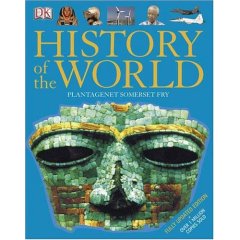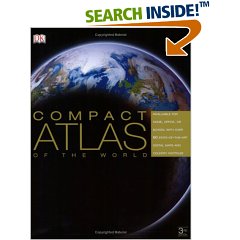|
 Essential Cross-Cultural Handbook of History
Essential Cross-Cultural Handbook of History
Reviewer: The Rebecca Review
"This work has been prepared with two major
objectives. The first is to provide a reference work which looks
at the world as an outsider – as though standing on the moon,
a possibility which is no longer the stuff of fantasy. The
second is to separate fact from interpretation." ~John B.
Teeple
DK is well known for their interest in creating some of the
most fascinating books you will ever read. Not only is this book
filled with full-color maps, it is also illustrated with
contemporary and archival photographs and artwork.
The features include: Entries organized according to dates
and geographic regions, beautifully illustrated timelines,
feature boxes and captions, cross-reference navigation tools,
introductory narrative for each timeline, encyclopedic Subject
Index and Glossary, comprehensive information on the arts,
science and technology, exploration, philosophy and religion.
The sidebars are used for detailed captions and additional
chronologies.
I also loved the "snapshot" maps where the pages
fold out and you can see how the world evolves over time. You
can visually compare the world in 1000 BCE with the world in
1975. The quick reference timelines at the start of each chapter
shows the most important events of that time period.
How is this book set up?
As you read through this book you will find four columns:
Asia, Africa, Europe and Americas & Australasian.
On page 454 and 455 you will see lots of information,
including the following facts:
ASIA: 2002 Musharraf wins Pakistan general election.
AFRICA: 2002 The threat of famine looms large in Zambia,
Zimbabwe, Angola, Mozambique, Swaziland, and Lesotho as crops
fail due to droughts and floods.
EUROPE: 2002 Single European currency – the Euro-introduced
in 11 of the 15 EU Member States.
AMERICAS & AUSTRALASIA: 2002 Estimated Internet users
worldwide 530 million.
On each side of the four columns, you will find pictures with
information on the Conflict in the Middle East, Asylum-seekers
in Europe and a summary of Sept 11.
While it doesn't seem much is going on in the Americas and
Australasia until page 249, you have to see this all in context.
Often this area is filled with pictures, so the space is not
wasted. Basically the timelines show what happened and when. It
is that simple.
This book spans from 10,000 BCE to 2002. For instance, you
will find entries like: c.1000 Adena culture develops in middle
Ohio river valley in eastern N America. Things start picking up
after pg. 271 when Christopher Columbus makes his appearance in
search of Asia and lands on the Bahamas on his first expedition.
The United States of America is not a big section of this
book, simply because it is a young country in comparison to
countries in Europe, Africa and Asia. I say all this to put the
information in this book into perspective. It does seem that the
editors went out of their way to include as much information as
they could before the 15th century.
The Main Contents include:
The World to 10,000 BCE
Timeline: 10,000-5000
The Advent of Agriculture: 5000-2500 BCE
The First Cities: 2500-1000 BCE
Early Civilizations: 1000-500 BCE
The Early Classical Age: 1-500 BCE-1 CE
The Later Classical Age: 1-500 CE
Successors to the Classical Age: 500-1000 CE
The Early Middle Ages: 1000-1200 CE
The High Middle Ages: 1200-1400
The Renaissance: 1400-1600
The Expanding World: 1600-1800
The Age of Revolution: 1800-1900
Clash of Empires: 1900-1925
Timelines: 1901-1915
World War I
The World in 1925
The World between the Wars: 1925-1950
World War II
Timelines: 1941-1950
The Cold War World 1950-1975
Timelines: 1951-1960
The Cold War/The End of Colonial Rule
Timelines: 1961-1975
The Modern World: 1975-2002
Concordance – This goes from page 458-666.
I find it interesting that this book has 666 pages. The
Concordance section of this book is worth the price alone. It is
a collection of major events, brief biographies of key
historical figures, lists of major rulers and leaders,
individual chronologies of each of the world's nations and also
acts as an index and glossary for the book.
If you are researching "Plato," you can look up his
name in the alphabetically arranged concordance section and not
only read about his basic philosophy, you will also be guided to
page 59 where you will the date of 384 where he wrote his
philosophical dialogue, The Symposium. If you look up United
States of America, you can find all the important dates like
1776, followed by a list of the Presidents of the United States.
If you are interested in world history and want to finally
organize your thoughts into an historical context, you will love
this book.
I think of this as a History Dictionary/Encyclopedia of
sorts. If I need information on any topic, from Microsoft to
Buddhism, this is a great place to start and I can then put all
the topics I’m researching into the proper historical
perspective. This is a good sturdy book with a beautiful
binding. A book you will be reading for years and years! I found
it to be very reliable and all the facts I knew by heart where
listed correctly.
Sadly, the author, John B. Teeple, passed away in the Spring
of 2002 and tragically never saw this book in its published
form. There is a foreword from the author and it beautifully
explains why this book was written.
"Timelines of World History" is Mind
Boggling! It is another DK masterpiece. If I could, I would give
this book 20 stars.
~The
Rebecca Review

History of the World
 Visual Journey through the Past, January 25, 2006
Visual Journey through the Past, January 25, 2006
The History of the World is now completely updated. Simon Adams
has continued the work of Plantagenet Somerset Fry (1946-1996)
and has worked on this book with a number of consultants who
have helped to make this book truly spectacular.
If you have ever wondered what an Etruscan headband looked like
(rather ornate gold leaves), caught yourself fascinated by
Polynesian navigation or love thinking about living in a castle,
this book has a lot to offer. Here you will find a picture of
the Mayflower and then a two-page section on the 1700-1750s
world, complete with a timeline. Actually every page has a
timeline running along the edge so you can instantly place the
information being discussed within context. The main chapters
include:
Introduction to Human History
Early People
The First Civilizations
Traders and Warriors
The Growth of Empires
The Decline of the Ancient World
Religious Worlds
New Nations
Monks and Invaders
Conquest and Plague
The Expansion of Knowledge
The Great Rulers
Commerce and Colonies
The Age of Inquiry
The Age of Revolution
Independence and Industry
The Rise of Nationalism
The World Goes to War
Peace and War
One World
Some of the unique features of this book include color-coded
information that is divided into five main regions: Africa,
Asia, Europe, the Americas and Oceania (Australasia, Papua New
Guinea and the Pacific Islands). Date-led entries provide
interesting details about significant developments in the world.
Artwork and modern pictures help to give a visual reference to
the key events pages. There are special feature pages to give a
space for descriptions of the culture being discussed and the
"illustrated comparative time charts" put the
information into perspective in a chronological order.
As you read through the book, you can watch the world change and
the pictures give a glimpse into the past, like the partially
restored Minoan palace at Knossos. You can learn fun things like
facts about the Inca's Freeze-dried potatoes and there is a
picture of a potato that is 500 years old that was being
preserved in case of a famine. Imagine having to remember how to
read information from a string called a quipu instead of
writing.
Population density maps give a better idea than numbers, a
special section on inventions and discoveries shows progress and
a comprehensive index and helpful glossary make this book even
more useful. Information about beaded amulets sewn back in the
1800s helps to explain why they are still popular today in bead
stores. The history of buildings page shows the endless variety
of creative expression. The lacquered and beaded items are
especially fascinating in this book.
This book can also be fun to read if you are just wandering
around this site. I looked up a Persian fruit bowl and ended up
finding some rose scented candles and beautiful china patterns.
A search for a Ming Chinese food dish brings up a book about
Chinese Medicine. It is very likely something in this book will
cause you to search for more information or you will enjoy
recognizing scenes from movies or world events.
While reading this book you take an epic journey through time
and suddenly history becomes much more interesting with all the
special features and unique illustrations.
~The Rebecca Review

World Atlas
 Essential Atlas for Quick Reference, January 25, 2006
Essential Atlas for Quick Reference, January 25, 2006
Have you ever found yourself thinking: "Where in the world
is that?" When faraway places make headline news, it is
helpful to have an easy-to-navigate Atlas to quickly locate
areas of interest. There are especially helpful elements in this
Atlas, like orange markings around Islands help to group them
together and all borders are shown in Orange, which may be even
more helpful if you are traveling.
The Key to Map Symbols is easy-to-understand and soon you get a
feel for elevations. The color-coded areas make finding
continents especially helpful, without even looking in the
index. At the end of the book, there is a section filled with
"Country Profiles" with information on pertinent
information like the official name or main religions and
languages. Population, total area, currency and Government
information is pretty interesting, but now you can even know the
average calorie consumption in all the countries.
This is the smaller Atlas and is helpful for quickly looking up
information. If you want to see all the countries in more depth
and explore culture and see photographs of the areas, then the
Concise Atlas of the World has over 400 digital maps and is the
perfect desktop reference edition. DK History of the World is
also highly recommended.
~The Rebecca Review
|